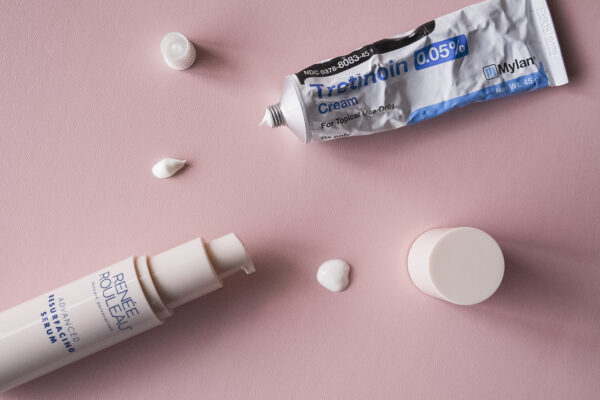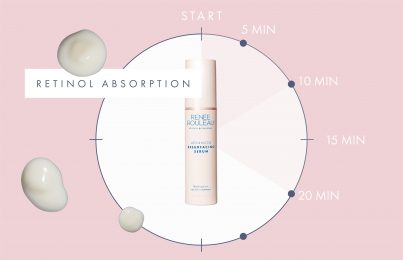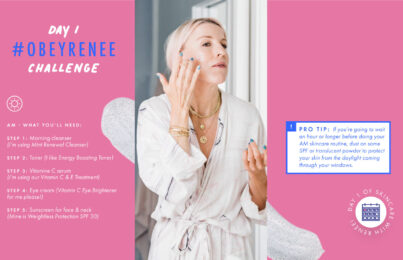I’ve been a big fan of retinol and prescription retinoids since they came on the scene for anti-aging in the early ’90s. However, back then, the lack of education and the availability of only prescription retinoids meant that the side effects could be quite severe. There was a limited understanding of how to use them properly to minimize these effects, which unfortunately discouraged many people from trying. Fast forward to today, and I’m not only thrilled that retinol is now available without a prescription, but I’m also incredibly excited about the new ways we’ve discovered to use it. Introducing: the retinol sandwich method.
Having worked with vitamin A and retinoids for a long time, it’s truly exciting to see what we can do with them now. So, what’s the reality behind this popular technique?
What is Retinol?
Let’s start from the top: What are retinol and retinoids? Derived from vitamin A, these are powerful agents that can address and reverse various signs of aging. These signs may include fine lines, wrinkles, post-breakout marks, enlarged pores, and brown spots. Whether in prescription form (like tretinoin) or over-the-counter options (such as Advanced Resurfacing Serum), retinoids have the potential to significantly enhance the skin’s appearance, promoting a more youthful, radiant-looking skin over time.
However, those who have used retinol or retinoids before have likely experienced a period of purging, otherwise known as “the retinol scaries.” This can be anything from an increase in breakouts to dryness, flaking, or irritation. Taking place almost immediately, this process happens while skin is adjusting to an increase in cell turnover. It’s because of this that lingering breakouts that might’ve taken weeks (or even months) to surface will all appear at once. This means that, before it gets better, your breakouts can actually get worse.
Not sure if this is right for your routine? Check out my beginner’s guide to retinol and retinoid usage!
What Is the Sandwich Method for Retinol?
While recently trending on TikTok, the retinol sandwich method isn’t a new concept in skincare at all. Sprouting from the ever-popular ‘moisture sandwich’ method, which promotes layering your products in order of viscosity, the idea of the retinol sandwich is to apply your retinol serum in between two layers of moisturizer (i.e. the bread) in an attempt to minimize its potential side effects. This is a great concept to try out if you’re someone with sensitive skin, a compromised barrier, or are new to the ingredient.
How Do You Sandwich Retinol?
Trying out this method is easy! Here’s the technique I recommend:
- In the PM, cleanse skin thoroughly
- Apply toner (or hydrating essence) and serum for your skin type
- Apply a lightweight, oil-free moisturizer to damp skin
- Allow this to dry completely
- Apply your retinol or retinoid
- Give your retinol time to absorb, then apply a second layer of the same moisturizer
This technique allows the first layer of moisturizer to act as a buffer between your skin and the hard-hitting active ingredient, while the second layer locks it all in. If you’re in need of additional buffering, I advise using an essence, like Moisture Infusion Toner, along with your toner and serum. Alcohol-free toners are great because water acts as a carrier to deliver ingredients deep into your skin, but in this case, that’s probably not something you’re seeking. By adding a serum-infused toner, or essence, you’re providing a little extra buffering as opposed to just a water-based toner.
Best Practices
I always recommend using a lightweight, non-greasy lotion for your skin type. Heavy creams have a larger molecule and, when applied before retinol or a prescription retinoid, prevent the actives from penetrating the skin. This is why I recommend a lighter, oil-free lotion, like Skin Recovery Lotion, that will provide a buffering layer of hydration without blocking the vitamin A product from working. That’s the key— you don’t want to dilute it to the point that it doesn’t work, just enough to take the edge off a little bit to manage some of the side effects.
Does the Retinol Sandwich Method Work?
This method can help mitigate irritation, dryness, and flaking while still providing youth-boosting benefits. If you have sensitive skin, want to focus on barrier protection, or are new to the ingredient, this is an effective option for limiting harsh side effects.
Does Sandwiching Retinol Between Moisturizer Make It Less Effective?
In short, no. When applying a it, you’re putting a specific percentage, say .1%, on your face. The percentage used doesn’t change no matter what you apply before or after it, meaning you aren’t making it less effective. However, what might change is the ability of the product to penetrate the skin. Applying moisturizer first does not necessarily dilute it, while mixing the two together would, but it does minimize the active’s ability to penetrate the skin.
All in all, using a hydrating cream before applying retinol won’t dilute its potency, it will just mitigate some of the negative side effects.
What Are the Benefits of the Retinol Sandwich Method?
By eliminating the usual side effects associated with retinol, skin will experience increased smoothness, hydration, and a brighter glow due to fewer opaque, dead skin cells. By creating a buffer, the skin barrier is less likely to become compromised, resulting in less dehydration and sensitivity.
Additionally, retinol sandwiching is a great option for those with acne-prone skin. Since acne-prone skin is already active and facing inflammation, I generally advise against using a stimulating active ingredient, as it can add even more inflammation. However, the sandwich method can make retinol more agreeable for skin, allowing those with acne to still receive anti-aging benefits
Should I Add It to My Routine?
If you’ve decided it’s time to start using retinol, then deciding if you want to add sandwiching to your routine is pretty simple: is it causing you unwanted dryness, redness, or irritation? Then give it a go! Even if you just want to spot treat particularly dry areas, such as around the eyes, nose, and mouth, you can apply moisturizer to just those areas before going in with retinol.
However, if you want to reap the maximum effects of retinol or retinoid and are okay with the typical side effects associated with this serum, you may want to opt out of sandwiching entirely.
Best Products To Use With the Retinol Sandwich Method
If you’re eager to try this ingredient but are concerned about the possible setbacks, you can start by sandwiching with any retinol or retinoid (here’s the difference), but I recommend keeping an eye out for one with these four things!
However, if you’re looking to skip the additional steps required for sandwiching, I recommend using a retinol gentle enough that a sandwich or phase-in period isn’t required, like Advanced Resurfacing Serum. Not all retinols are created equally due to varying strengths and intensities, and this serum is formulated for sensitive skin and for those whose skin has been unable to tolerate prescription retinoids. From here you can work your way up to a more powerful option without the additional steps or products.
Experiencing the retinol scaries? Our new Rest Day Masque is a deeply moisturizing and reparative treatment that will instantly correct parched skin, tightness, and visible flaking often caused by actives such as retinoids, exfoliating acids, or benzoyl peroxide.
What Are There Cons to Sandwiching Retinol?
While sandwiching is a safe and effective way to reduce irritation, these are a few things you should consider before trying it out yourself.
- Slower results: Because sandwiching reduces the absorption of product, it may take longer to see visible results compared to using retinol alone.
- Potential for irritation: While sandwiching can reduce the likelihood of irritation, some people may still experience some, depending on the thickness of the moisturizer, concentration of ingredients, and sensitivity of skin.
- Cost and product usage: Using more product (two layers of moisturizer) each time you apply retinol can lead to faster depletion of your products and increased cost over time.
How Often Should I Use This Technique?
How often you use this method can be very similar to lifting weights. Somedays, you may only want to lift 5lbs, while other days you may opt for 20lbs if you know you’re going to have some extra downtime after. I really believe that a “no pain, no gain” philosophy can be applied to retinol usage.
If you’re a retinol beginner, I would suggest using this method 1-2 times per week, gradually increasing the frequency as your skin adjusts. However, I know that if I don’t have any special occasions or a need to be filming anytime soon, then I don’t mind my skin peeling a little if that means receiving more noticeable results. Also, oilier skin types may not need to sandwich as much as others since their oil acts as their own built-in buffering method.
Remember, retinol causes skin to be more susceptible to sunburns so make sure you are only using it at night (and don’t forget sunscreen in the morning!).
Ultimately, the retinol sandwich method is a great technique to utilize if you want the anti-aging results without the drawbacks. Just understand that you may not see results as quickly if you aren’t pushing your skin’s limits.
Celebrity Esthetician & Skincare Expert
As an esthetician trained in cosmetic chemistry, Renée Rouleau has spent 30 years researching skin, educating her audience, and building an award-winning line of products. Her hands-on experience as an esthetician and trusted skin care expert has created a real-world solution — products that are formulated for nine different types of skin so your face will get exactly what it needs to look and feel its best. Trusted by celebrities, editors, bloggers, and skincare obsessives around the globe, her vast real-world knowledge and constant research are why Marie Claire calls her “the most passionate skin practitioner we know.”



